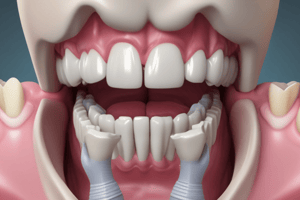Podcast
Questions and Answers
What is the definition of an ideal occlusion?
What is the definition of an ideal occlusion?
- An anatomically perfect arrangement of the teeth (correct)
- An arrangement of teeth with no contact between them
- A misaligned arrangement of teeth
- An arrangement of teeth with irregular spacing
Which of the following best describes static occlusion?
Which of the following best describes static occlusion?
- Occlusal contacts during speech, mastication, and swallowing
- Misalignment of the teeth during function
- Study of contacts between the teeth when the jaw is not moving (correct)
- Relationship of teeth to their supporting structure
What does functional occlusion refer to?
What does functional occlusion refer to?
- Arrangement of teeth with irregular spacing during speech
- Misalignment of the teeth during function
- Occlusal contacts during speech, mastication, and swallowing (correct)
- Relationship of teeth to their supporting structure
What does the study of occlusion involve?
What does the study of occlusion involve?
Which term refers to the function of the stomatognathic system as a whole?
Which term refers to the function of the stomatognathic system as a whole?
Flashcards are hidden until you start studying
Study Notes
Occlusion
- Ideal occlusion is defined as the harmonious contact of the upper and lower teeth, resulting in optimal function and aesthetics.
Types of Occlusion
- Static occlusion refers to the contact between the upper and lower teeth when the jaws are closed, but not functioning (e.g., at rest).
Functional Occlusion
- Functional occlusion refers to the dynamic contact between the upper and lower teeth during movements of the mandible (lower jawbone), such as during chewing, speaking, or swallowing.
Study of Occlusion
- The study of occlusion involves the analysis of the form and function of the teeth, the temporomandibular joints (TMJs), and the surrounding muscles and nervous system.
Stomatognathic System
- The stomatognathic system refers to the function of the teeth, jaws, and surrounding tissues as a whole, including the TMJs, facial muscles, and nervous system.
Studying That Suits You
Use AI to generate personalized quizzes and flashcards to suit your learning preferences.




